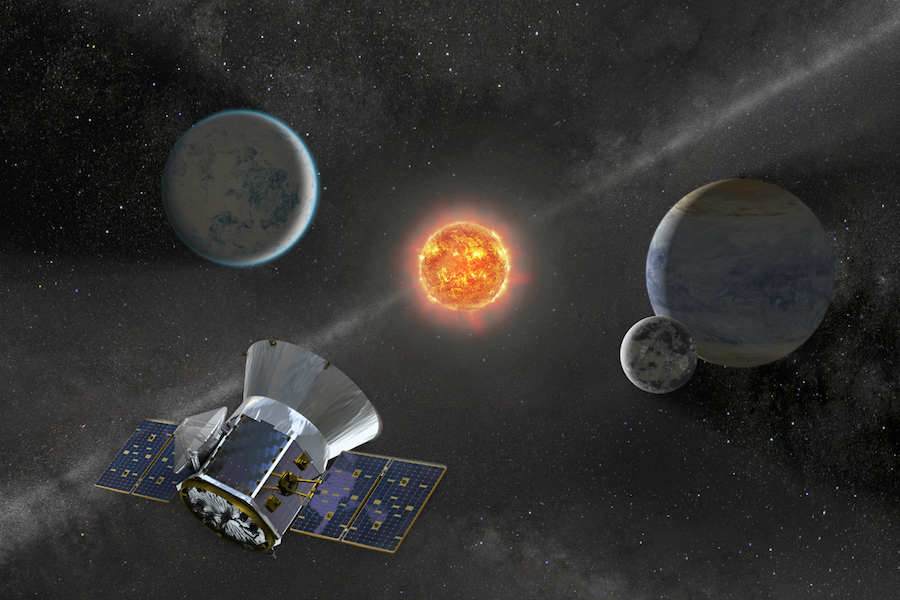Six months into its mission scanning the sky for planets around other stars, NASA’s orbiting TESS observatory has found three previously-undiscovered worlds and hundreds candidates requiring follow-up observations, the first batch of a potential haul of up to 10,000 exoplanet detections over TESS’s planned two-year mission, astronomers announced this week.
NASA’s Transiting Exoplanet Survey Satellite launched in April 2018 and started scientific observations in July. TESS is the space agency’s latest exoplanet-hunting space telescope, following the Kepler mission which ended its search for worlds around other stars when it ran out of fuel last year.
“We’re only halfway through TESS’s first year of operations, and the data floodgates are just beginning to open,” said George Ricker, TESS’s principal investigator at MIT’s Kavli Institute for Astrophysics and Space Research. “When the full set of observations of more than 300 million stars and galaxies collected in the two-year prime mission are scrutinized by astronomers worldwide, TESS may well have discovered as many as 10,000 planets, in addition to hundreds of supernovae and other explosive stellar and extragalactic transients.”
Astronomers so far have discovered nearly 3,900 exoplanets in total, nearly 2,700 of which were detected by Kepler.
TESS has four 16.8-megapixel science cameras designed to search for dips in light coming from stars caused by transiting planets. Astronomers can measure the size of exoplanets using TESS’s observations, then derive a mass estimate using other techniques such as measurements of the parent’s stars wobble caused by the gravitational pull of its planetary companion.
The three confirmed planets discovered so far using TESS are all within 100 light-years of our solar system, substantially closer than the nearly 2,700 validated worlds detected using Kepler.
The first confirmed exoplanet found with TESS is named Pi Mensae c, located around 60 light-years away around the star Pi Mensae, visible to the naked eye in the southern constellation Mensa. Pi Mensae c is about twice the size of Earth and orbits once every 6.3 days around its parent star, which is similar in mass and size to the sun.
“This star was already known to host a planet, called Pi Mensae b, which is about 10 times the mass of Jupiter and follows a long and very eccentric orbit,” said Chelsea Huang, a Juan Carlos Torres Fellow at MIT’s Kavli Institute for Astrophysics and Space Research. “In contrast, the new planet, called Pi Mensae c, has a circular orbit close to the star, and these orbital differences will prove key to understanding how this unusual system formed.”

Astronomers believe another exoplanet detected by TESS — formally named LHS 3884b — has a rocky make-up and is located around 49 light-years away in the constellation Indus. LHS 3884b orbits so close to its parent star — a relatively cool M-dwarf type star about one-fifth the size of the sun — that some of its rocky surface on the starlit side of the planet may form pools of molten lava with surface temperatures around 1,000 degrees Fahrenheit (537 degrees Celsius), scientists said. LHS 3884b completes one trip around its star every 11 hours, and TESS found the planet is about 1.3 times the size of Earth.
TESS also discovered one confirmed planet and another exoplanet candidate around the same K-type star around 80 percent the sun’s mass, located some 53 light-years away in the southern constellation Reticulum.
The confirmed planet, named HD 21749b, is roughly three times the size of Earth, but 23 times its mass, leading scientists to infer that it could be covered in a deep ocean, or harbor a thick atmospheric shroud. It orbits its star every 36 days and has a surface temperature around 300 degrees Fahrenheit (150 degrees Celsius), NASA said in a statement.
“This planet has a greater density than Neptune, but it isn’t rocky. It could be a water planet or have some other type of substantial atmosphere,” said Diana Dragomir, a Hubble Fellow at MIT’s Kavli Institute for Astrophysics and Space Research.
HD 21749b “is the longest-period transiting planet within 100 light-years of the solar system, and it has the coolest surface temperature of a transiting exoplanet around a star brighter than 10th magnitude, or about 25 times fainter than the limit of unaided human vision,” NASA said.
The second planet candidate around the same star appears to be about the size of the Earth, in an orbit that takes it around the star once every eight days, astronomers said.
From the mission’s first three months of observations, astronomers found 280 possible planets that require follow-up confirmation using ground-based telescopes.
Scientists announced the early TESS results at the 233rd meeting of the American Astronomical Society in Seattle this week.
After its launch from Cape Canaveral last year, TESS maneuvered into a unique high-altitude orbit that ranges in distance between 67,000 miles (108,000 kilometers) and 233,000 miles (376,000 kilometers) from Earth, putting the spacecraft in a stable orbit in gravitational resonance with the moon. TESS requires little propellant to maintain its orbit, leading lead scientist Ricker to predict the mission could continue its exoplanet search for 20 or 30 years, assuming NASA funding and spacecraft components hold up.
TESS will scan around 85 percent of the sky during its two-year prime mission, beginning with stars in the southern sky. Later this year, the observatory will shift its aim to the northern sky. Its cameras are designed to pick up exoplanet signals from relatively bright, nearby stars, including those visible to the naked eye.
In contrast, Kepler focused its telescope at specific patches of the sky, using a deep staring method to search for planetary transits around distant, dim stars.
Email the author.
Follow Stephen Clark on Twitter: @StephenClark1.



